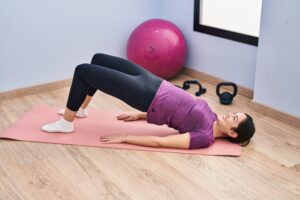 Isometric exercises for high blood pressure are gaining attention as a powerful, natural way to manage this common health condition. High blood pressure—often referred to as the “silent killer”—affects nearly half of adults in the U.S. It usually shows no symptoms but significantly raises the risk of heart disease, stroke, and kidney damage.
Isometric exercises for high blood pressure are gaining attention as a powerful, natural way to manage this common health condition. High blood pressure—often referred to as the “silent killer”—affects nearly half of adults in the U.S. It usually shows no symptoms but significantly raises the risk of heart disease, stroke, and kidney damage.
While medications are often necessary, more people are turning to lifestyle changes to help lower their numbers—and isometric exercises are proving to be a surprisingly effective and underrated method.
In this article, we’ll break down how isometric exercises for high blood pressure work, what the latest research says, and how you can get started today—even if you’re new to fitness.
What Are Isometric Exercises?
Isometric exercises are strength training moves where your muscles contract without changing length. In simple terms, you hold a position rather than moving through a range of motion. Think of wall sits, planks, or squeezing a stress ball. No equipment is necessary, and you won’t break a sweat—but your body will thank you.
These exercises work by creating tension in your muscles, which then signals your nervous system to regulate blood flow and improve vascular function. Studies have shown that isometric training can significantly lower systolic and diastolic blood pressure—sometimes even better than aerobic exercises.
The Science Behind It
 A growing body of research supports the benefits of isometric training for people with high blood pressure. A 2023 meta-analysis published in the British Journal of Sports Medicine found that isometric exercises were among the most effective forms of exercise for reducing blood pressure—more so than traditional cardio or weightlifting.
A growing body of research supports the benefits of isometric training for people with high blood pressure. A 2023 meta-analysis published in the British Journal of Sports Medicine found that isometric exercises were among the most effective forms of exercise for reducing blood pressure—more so than traditional cardio or weightlifting.
Why does this happen?
When you hold an isometric position, the blood vessels constrict slightly, then relax, which improves their flexibility and overall function. Over time, this helps lower resting blood pressure levels. Think of it like giving your arteries a gentle daily workou
Top Isometric Exercises for High Blood Pressure
Ready to give it a try? Here are some beginner-friendly isometric exercises you can do at home:
1. Wall Sit

How to do it: Stand against a wall and slide down into a seated position with your knees at 90 degrees. Hold for 20–30 seconds.
Benefits: Engages major muscle groups and improves circulation.
2. Plank

How to do it: Get into a forearm plank position, keeping your body in a straight line from head to heels. Hold for 20–60 seconds.
Benefits: Strengthens the core and supports vascular health.
3. Handgrip Exercise

How to do it: Squeeze a soft ball or grip device with moderate intensity for 2 minutes, then switch hands.
Benefits: Proven in clinical studies to reduce systolic blood pressure over time.
4. Glute Bridge Hold

- How to do it: Lie on your back with knees bent and feet flat. Lift your hips and hold for 30 seconds.
start with 2–3 sessions per week and gradually build up duration and frequency as your endurance improves. Always consult with your doctor before starting a new exercise program, especially if you have existing heart conditions.
Benefits: Activates the core and glutes while enhancing blood flow.
Pro Tips to Maximize Results
Breathe Normally: Don’t hold your breath during isometric exercises. It can temporarily raise blood pressure.
Stay Consistent: Like any form of exercise, consistency is key. Aim for 4–6 weeks to notice measurable changes.
Monitor Progress: Keep a blood pressure journal. Record your readings before and after starting the routine.
Final Thoughts
If you’re looking for a simple, effective, and low-impact way to manage your blood pressure, isometric exercises might be your new best friend. They’re easy to learn, require zero equipment, and can be done in just a few minutes a day.
With scientific backing and real-life success stories, this form of training offers a safe, drug-free approach to heart health. Add it to your wellness toolbox—and give your blood pressure a natural boost in the right direction.
Looking for more ways to support your heart health?
If you found this helpful, chances are you’ll also enjoy our previous post. We covered more practical tips that complement isometric exercises for high blood pressure.
👉 Check out our last blog here and take the next step toward a healthier lifestyle.
Don’t forget to share this post with someone who might benefit—and stay tuned for more wellness tips every week!
